Are There Crocodiles In Mexican Cenotes, and is it safe to swim? Yes, crocodiles can inhabit some Mexican cenotes, offering a unique and thrilling, or perhaps slightly unnerving, experience. This guide from gaymexico.net explores cenotes with crocodiles, particularly focusing on the famous Casa Cenote, ensuring LGBTQ+ travelers are well-informed about these incredible natural wonders in Mexico. Discover more about cenote safety, wildlife encounters, and unforgettable experiences.
Here’s what you need to know: Wildlife safety, eco-tourism, adventure travel.
1. Understanding Cenotes and Their Ecosystems
What exactly are cenotes, and why are they so special?
Cenotes are natural sinkholes formed by the collapse of limestone bedrock, exposing the groundwater underneath. These stunning geological formations are prevalent in the Yucatán Peninsula, with estimates suggesting over 6,000 of them exist. These water-filled caves and underground rivers were sacred to the ancient Maya, who believed they were gateways to the underworld. Today, they are popular tourist destinations for swimming, snorkeling, diving, and exploring the unique ecosystems they harbor.
Cenotes vary greatly in their characteristics. Some are open-air pools, while others are underground caves with stalactites and stalagmites. The water in cenotes is typically cool and crystal clear, filtered through the limestone rock. This creates incredible visibility for underwater exploration. Cenotes are not just visually stunning; they also play a vital role in the region’s ecosystem, providing habitats for diverse flora and fauna.
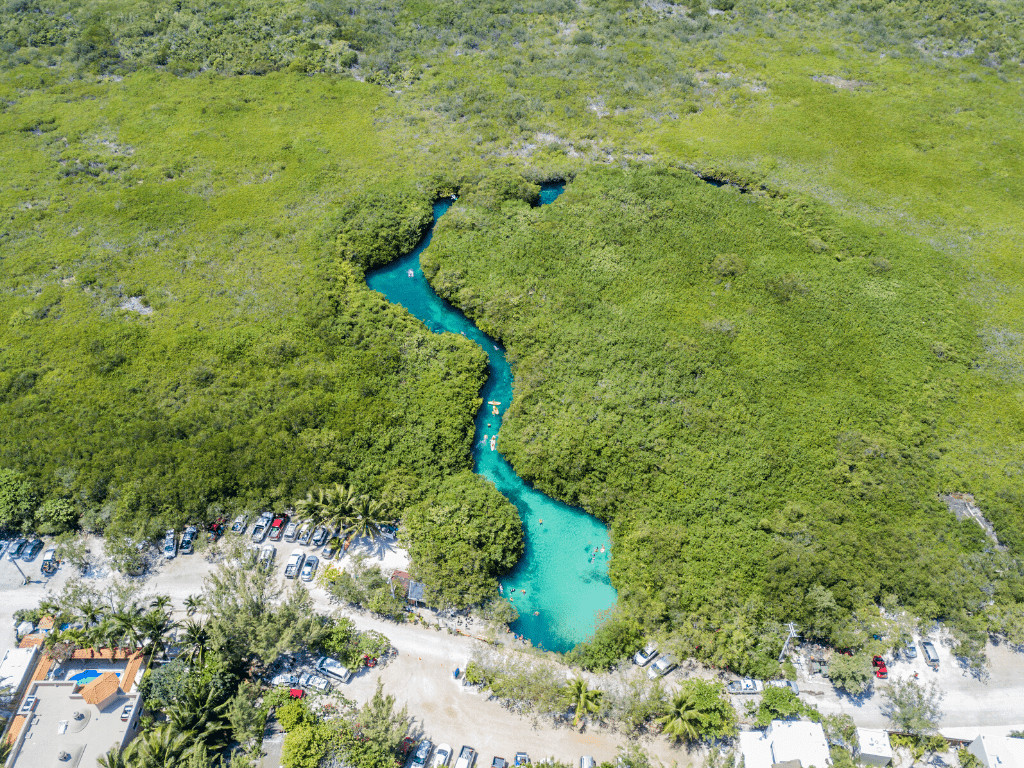 Casa Cenote seen from above in Tulum, Mexico
Casa Cenote seen from above in Tulum, Mexico
2. Crocodiles in Cenotes: Fact or Fiction?
So, are crocodiles commonly found in Mexican cenotes?
While not all cenotes are home to crocodiles, some do indeed have these reptiles. Crocodiles are more likely to be found in cenotes that have a connection to the ocean or other brackish water sources. This is because crocodiles, particularly the American crocodile (Crocodylus acutus), can tolerate saltwater environments. According to a study by the National Autonomous University of Mexico (UNAM), cenotes near the coast are more likely to host crocodile populations due to their accessibility via underground river systems.
The presence of crocodiles in cenotes is not necessarily a cause for alarm, but it is essential to be aware of the possibility. In most cases, the crocodiles are relatively small and accustomed to human presence, posing little threat. However, it is crucial to exercise caution and respect their habitat.
3. Casa Cenote: Home to “Pancho” the Crocodile
What makes Casa Cenote unique, and who is Pancho?
Casa Cenote, also known as Cenote Manatí, is a standout example of a cenote where you might encounter a crocodile. Located near Tulum, this open-air cenote is connected to the ocean, resulting in brackish water that supports a unique array of marine life. This includes various fish species, blue crabs, and, most famously, a crocodile named Pancho (or Panchito).
Pancho is a small to medium-sized crocodile that has resided in Casa Cenote since he was a juvenile. Over time, he has become accustomed to the presence of humans and is generally considered docile. Visitors often report seeing Pancho swimming alongside them or basking in the sun near the mangroves. While Pancho is generally harmless, it is still important to maintain a safe distance and respect his space.
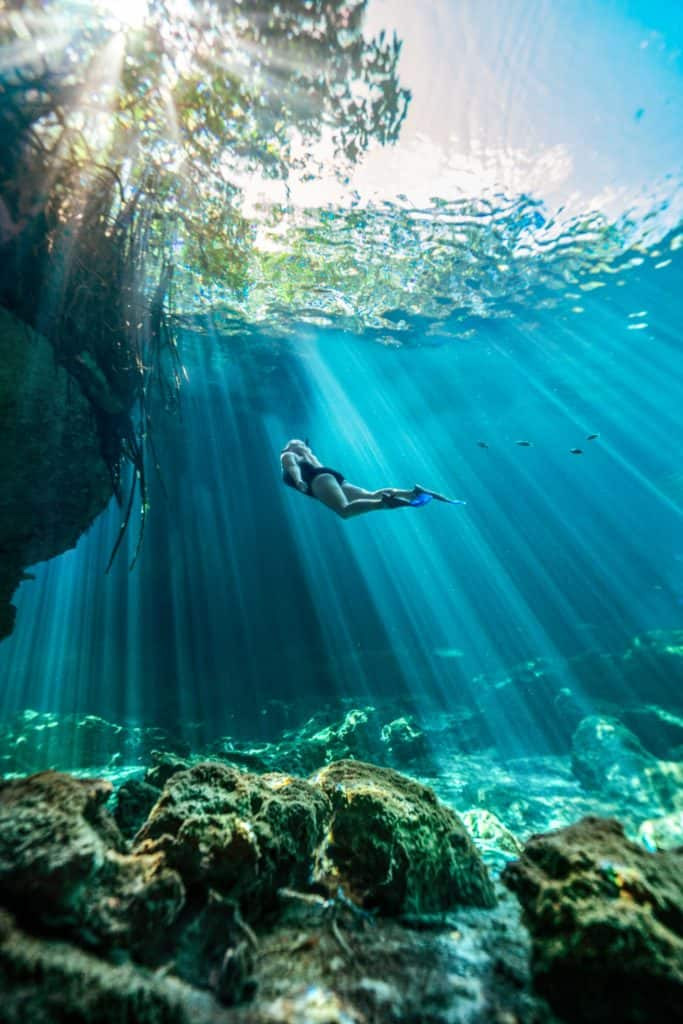 Swimming in Casa Cenote in Tulum, Mexico
Swimming in Casa Cenote in Tulum, Mexico
4. Safety Measures and Responsible Tourism in Cenotes
How can visitors stay safe and protect the environment while visiting cenotes?
When visiting cenotes, especially those where crocodiles may be present, it is crucial to prioritize safety and practice responsible tourism. Here are some essential tips to keep in mind:
4.1. Follow Guidelines
Adhere to all posted rules and regulations at the cenote. These guidelines are in place to protect both visitors and the environment.
4.2. Maintain Distance
Keep a safe distance from any wildlife you encounter, including crocodiles. Do not attempt to feed or interact with them.
4.3. Supervise Children
Closely supervise children at all times and ensure they understand the importance of respecting wildlife.
4.4. Avoid Touching
Refrain from touching or disturbing the cenote’s rock formations, stalactites, or stalagmites.
4.5. Use Eco-Friendly Products
Avoid wearing sunscreen, lotions, or insect repellent while swimming in the cenote, as these products can harm the delicate ecosystem. Use reef-safe, biodegradable alternatives if necessary.
4.6. Respect the Environment
Do not litter or leave any trash behind. Help keep the cenote clean and pristine for future visitors.
4.7. Hire a Guide
Consider hiring a local guide who is knowledgeable about the cenote and its wildlife. They can provide valuable insights and ensure your safety.
By following these simple guidelines, you can enjoy the beauty of cenotes while minimizing your impact on the environment and ensuring a safe and enjoyable experience.
5. How to Get to Casa Cenote
What’s the best way to reach Casa Cenote from Tulum?
Casa Cenote is conveniently located approximately 15 minutes north of Tulum, right off the main highway towards Cancun. To get there, simply enter “Casa Cenote” into your GPS or preferred navigation app. Once you turn off the highway, you’ll drive along a dirt road, passing through a security gate into a semi-private community. Continue past a few rental houses and the adjacent hotel until you see the sign for Casa Cenote. The cenote offers free parking right next to the entrance, making it easily accessible for visitors.
 Free diving at Casa Cenote in Tulum, Mexico
Free diving at Casa Cenote in Tulum, Mexico
6. Casa Cenote Entrance Fee and Amenities
What are the costs and services available at Casa Cenote?
The entrance fee to Casa Cenote is around 500 pesos per person, which is approximately $25 USD. If you plan to bring a GoPro or other action camera, there is an additional fee of 100 pesos (about $5 USD). It is advisable to bring cash for these fees.
Casa Cenote is a well-established tourist destination and offers several amenities for visitors. You can rent life vests, snorkels, and other equipment on-site. Guided tours are also available, with knowledgeable guides who can show you around the cenote and share insights about its history, geology, and wildlife.
7. A Personal Encounter with Pancho: A Thrilling Experience
Can you share a firsthand experience of swimming with a crocodile at Casa Cenote?
Many visitors have had memorable experiences swimming in Casa Cenote, some even encountering Pancho the crocodile. Here’s one such account:
“Our guides, Oscar and Jess, from Serenity Free Diving, took us to Casa Cenote. They mentioned we might spot Pancho but said it wasn’t very likely. The water’s clarity was stunning, making it easy to see fish and blue crabs.
As we floated along the cenote’s natural lazy river, sunlight created magical patterns among the mangrove roots. Reaching the far end, we spotted Pancho sunbathing on a rock surrounded by mangroves. It was the closest I’d ever been to a wild crocodile, and I felt vulnerable but also thrilled.
Later, while exploring the mangroves underwater, we saw Pancho swimming beneath us. Adrenaline surged as I surfaced, and we watched him from a distance. He seemed curious but remained docile. Swimming with a crocodile was an unforgettable experience!”
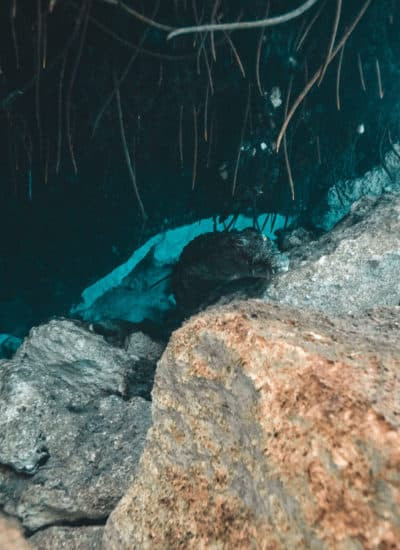 Pancho the Crocodile swimming in the mangrove roots at Casa Cenote in Tulum, Mexico
Pancho the Crocodile swimming in the mangrove roots at Casa Cenote in Tulum, Mexico
8. Tips for an Unforgettable Visit to Casa Cenote
What should visitors keep in mind to make the most of their trip?
To make the most of your visit to Casa Cenote, keep these tips in mind:
8.1. Be Prepared for a Crocodile Encounter
While sightings are not guaranteed, be mentally prepared for the possibility of encountering Pancho. Swim at your own risk, respect the wildlife, and avoid getting too close.
8.2. Pack Appropriately
Bring a towel, or rent one at the cenote. Consider packing or renting a mask, snorkel, and fins to fully appreciate the underwater beauty. Fins can be helpful for swimming against the current or diving deeper.
8.3. Bring Cash
Carry cash for the entrance fee (500 pesos per person) and the camera fee (100 pesos if you plan to use a GoPro).
8.4. Protect the Environment
Rinse off any lotions, sunscreen, or bug spray before entering the cenote, or apply them after swimming. These products can harm the cenote’s delicate ecosystem.
 Swimming in Casa Cenote in Tulum, Mexico
Swimming in Casa Cenote in Tulum, Mexico
9. Cenotes and the LGBTQ+ Community in Mexico
How can gaymexico.net help LGBTQ+ travelers explore cenotes safely and enjoyably?
At gaymexico.net, we understand the unique needs and concerns of LGBTQ+ travelers. We are committed to providing comprehensive and up-to-date information to help you explore Mexico safely and enjoyably. When it comes to visiting cenotes, we offer guidance on:
9.1. Safe and Welcoming Destinations
Identifying cenotes that are known for being inclusive and welcoming to LGBTQ+ visitors.
9.2. Local Resources and Support
Connecting you with LGBTQ+ friendly tour operators and guides who can provide personalized experiences.
9.3. Cultural Sensitivity
Offering insights into local customs and etiquette to ensure respectful interactions with the community.
9.4. Safety Information
Providing tips and advice on staying safe while traveling in Mexico, including information on local laws and resources.
9.5. Community Connections
Facilitating connections with LGBTQ+ locals and expats who can share their experiences and recommendations.
We believe that everyone should have the opportunity to experience the beauty and wonder of Mexico’s cenotes. Through our website and resources, we strive to empower LGBTQ+ travelers to explore these incredible destinations with confidence and pride.
10. Other Cenotes to Explore in the Yucatan Peninsula
Aside from Casa Cenote, what are some other noteworthy cenotes in the region?
The Yucatan Peninsula is home to thousands of cenotes, each with its unique charm and attractions. Here are a few other notable cenotes to consider exploring:
10.1. Gran Cenote
Located near Tulum, Gran Cenote is one of the most popular and well-known cenotes in the area. It features crystal-clear water, impressive rock formations, and abundant marine life. It’s a great spot for snorkeling and diving.
10.2. Cenote Dos Ojos
Also near Tulum, Cenote Dos Ojos (Two Eyes Cenote) is famous for its stunning underwater cave system. It’s a popular destination for experienced divers looking to explore the depths of the Yucatan’s underground rivers.
10.3. Cenote Ik Kil
Close to Chichen Itza, Cenote Ik Kil is a visually striking open-air cenote with cascading vines and turquoise waters. It’s a popular spot for swimming and taking photos, often included in tours of the Chichen Itza archaeological site.
10.4. Cenote Suytun
Near Valladolid, Cenote Suytun is famous for its unique platform that extends into the cenote, creating a dramatic photo opportunity when the sun shines through the opening above.
10.5. Cenote Samula and Xkeken
Located near Valladolid, these cenotes are often visited together. Cenote Samula features a small opening in the ceiling that allows a single beam of sunlight to illuminate the water, while Cenote Xkeken is known for its impressive stalactites.
Each of these cenotes offers a unique experience, from swimming in crystal-clear waters to exploring intricate cave systems. When planning your trip to the Yucatan Peninsula, be sure to include a few of these stunning natural wonders on your itinerary.
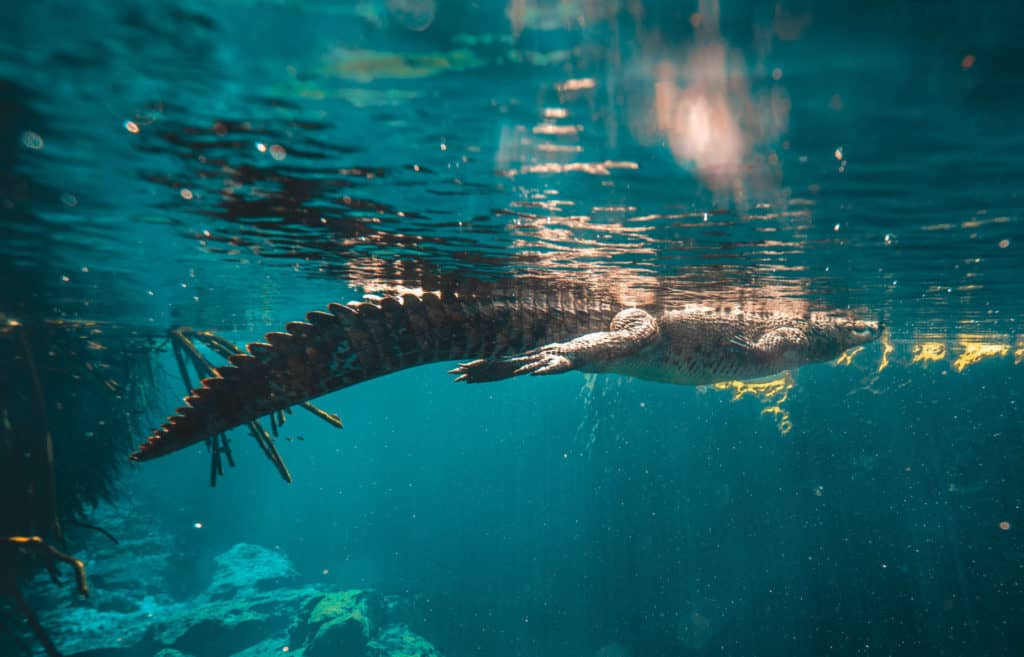 Pancho the Crocodile swimming in Casa Cenote in Tulum, Mexico
Pancho the Crocodile swimming in Casa Cenote in Tulum, Mexico
11. Understanding Crocodile Behavior and Safety
What should you know about crocodile behavior to stay safe in cenotes?
While encounters with crocodiles in cenotes are relatively rare and often uneventful, it’s essential to understand their behavior and take necessary precautions. Here are some key points to keep in mind:
11.1. Respect Their Space
Crocodiles are wild animals, and it’s crucial to respect their natural habitat. Avoid approaching them or attempting to interact with them.
11.2. Observe from a Distance
If you spot a crocodile, observe it from a safe distance. Do not attempt to get closer for photos or videos.
11.3. Avoid Feeding
Never feed crocodiles, as this can alter their behavior and make them more likely to approach humans.
11.4. Be Aware of Nesting Season
During nesting season (typically from April to June), crocodiles can be more protective of their territory. Be extra cautious during this time and avoid areas where nests may be present.
11.5. Follow Local Advice
Pay attention to any warnings or advice provided by local guides or authorities. They are the most knowledgeable about the behavior of crocodiles in the area.
11.6. Stay Calm
If a crocodile approaches you, stay calm and slowly back away. Avoid making sudden movements or loud noises.
By understanding crocodile behavior and following these safety tips, you can minimize the risk of an encounter and enjoy your visit to cenotes with peace of mind. According to research from the University of Florida’s Institute of Food and Agricultural Sciences, in July 2023, avoiding direct interaction and maintaining distance provides safe tourism with wildlife.
12. Eco-Friendly Practices for Cenote Exploration
How can tourists minimize their environmental impact when visiting cenotes?
Cenotes are delicate ecosystems that are vulnerable to human impact. To help protect these natural wonders, it’s essential to practice eco-friendly tourism. Here are some simple steps you can take:
12.1. Choose Reef-Safe Sunscreen
Conventional sunscreens contain chemicals that can harm aquatic life. Opt for reef-safe, biodegradable sunscreens that are free of oxybenzone and octinoxate.
12.2. Avoid Chemical Products
Minimize the use of lotions, insect repellent, and other chemical products before entering the cenote. These substances can pollute the water and harm the ecosystem.
12.3. Don’t Touch
Avoid touching or disturbing the cenote’s rock formations, stalactites, and stalagmites. These formations are fragile and take thousands of years to form.
12.4. Pack Out All Trash
Do not litter or leave any trash behind. Pack out everything you bring with you, including food wrappers, water bottles, and other waste.
12.5. Respect Wildlife
Observe wildlife from a distance and avoid feeding or disturbing animals.
12.6. Support Sustainable Tourism
Choose tour operators and guides who are committed to sustainable tourism practices. Look for companies that prioritize environmental protection and community involvement.
By adopting these eco-friendly practices, you can help preserve the beauty and integrity of cenotes for future generations.
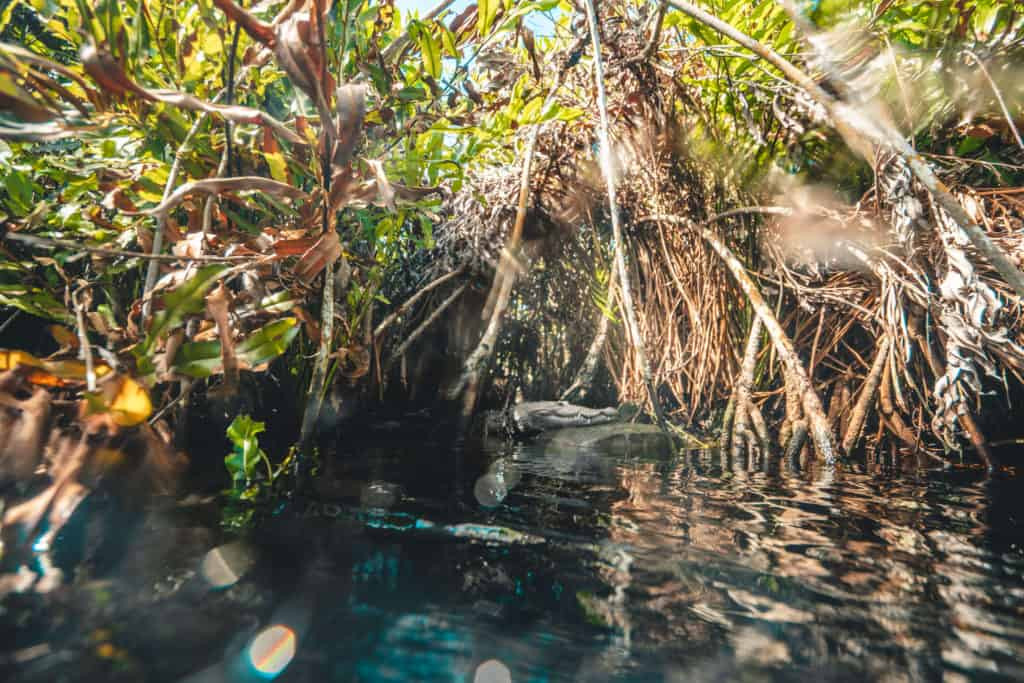 Pancho the Crocodile in the mangroves at Casa Cenote in Tulum, Mexico
Pancho the Crocodile in the mangroves at Casa Cenote in Tulum, Mexico
13. The Cultural Significance of Cenotes
Why were cenotes considered sacred by the ancient Maya civilization?
Cenotes held a profound cultural and spiritual significance for the ancient Maya civilization. They were considered sacred places, believed to be gateways to the underworld, known as Xibalba. The Maya used cenotes as sources of fresh water, as well as for religious ceremonies and sacrifices.
Archaeological evidence suggests that the Maya performed various rituals in cenotes, including offerings of pottery, jewelry, and even human sacrifices. These offerings were intended to appease the gods and ensure the continued prosperity of the community.
Cenotes were also seen as symbols of fertility and life. The Maya believed that the water in cenotes was connected to the rain god, Chaac, and that these sacred pools had the power to bring life and abundance to the land.
Today, cenotes continue to hold cultural significance for the Maya people, who still consider them sacred places. Visitors are encouraged to respect the cultural heritage of cenotes and to treat them with reverence.
14. Cenotes and Scientific Research
What can cenotes teach us about the environment and history?
Cenotes are not only popular tourist destinations but also valuable sites for scientific research. Their unique geological formations and ecosystems provide insights into the region’s environment and history.
14.1. Groundwater Studies
Cenotes provide access to the Yucatan Peninsula’s groundwater, allowing scientists to study water quality, flow patterns, and the impact of human activities on this vital resource.
14.2. Climate Change Research
The sediments and fossils found in cenotes can provide valuable data about past climate conditions, helping scientists understand the long-term effects of climate change.
14.3. Archaeological Discoveries
Cenotes have yielded numerous archaeological artifacts, providing insights into the ancient Maya civilization and their religious practices.
14.4. Biodiversity Studies
Cenotes are home to unique species of plants and animals, some of which are found nowhere else in the world. Studying these species can help scientists understand the evolution and adaptation of life in isolated environments.
By supporting scientific research in cenotes, we can gain a deeper understanding of the region’s environment, history, and cultural heritage.
15. Frequently Asked Questions (FAQs) about Crocodiles in Cenotes
Have more questions? Here are some frequently asked questions:
15.1. Is it safe to swim in cenotes with crocodiles?
Generally, yes. Crocodiles in cenotes like Casa Cenote are often accustomed to humans and docile. However, always maintain a safe distance and respect their space.
15.2. Are there crocodiles in all cenotes?
No, not all cenotes have crocodiles. They are more likely to be found in cenotes connected to the ocean or brackish water sources.
15.3. What should I do if I see a crocodile in a cenote?
Stay calm, observe from a distance, and avoid approaching or feeding the crocodile.
15.4. Can I bring sunscreen to cenotes?
Use reef-safe, biodegradable sunscreen to protect the cenote’s ecosystem.
15.5. What is the entrance fee for Casa Cenote?
The entrance fee is around 500 pesos per person, with an additional 100 pesos for bringing a GoPro.
15.6. Are there guided tours available at Casa Cenote?
Yes, guided tours are available, providing valuable insights and ensuring your safety.
15.7. What other cenotes should I visit in the Yucatan Peninsula?
Consider visiting Gran Cenote, Cenote Dos Ojos, Cenote Ik Kil, Cenote Suytun, and Cenote Samula and Xkeken.
15.8. How can I travel responsibly when visiting cenotes?
Follow eco-friendly practices, respect wildlife, and support sustainable tourism operators.
15.9. What was the cultural significance of cenotes for the Maya?
Cenotes were considered sacred places, gateways to the underworld, and sources of fresh water for the Maya civilization.
15.10. How can I find LGBTQ+-friendly cenotes in Mexico?
Visit gaymexico.net for resources, tips, and recommendations for LGBTQ+ travelers.
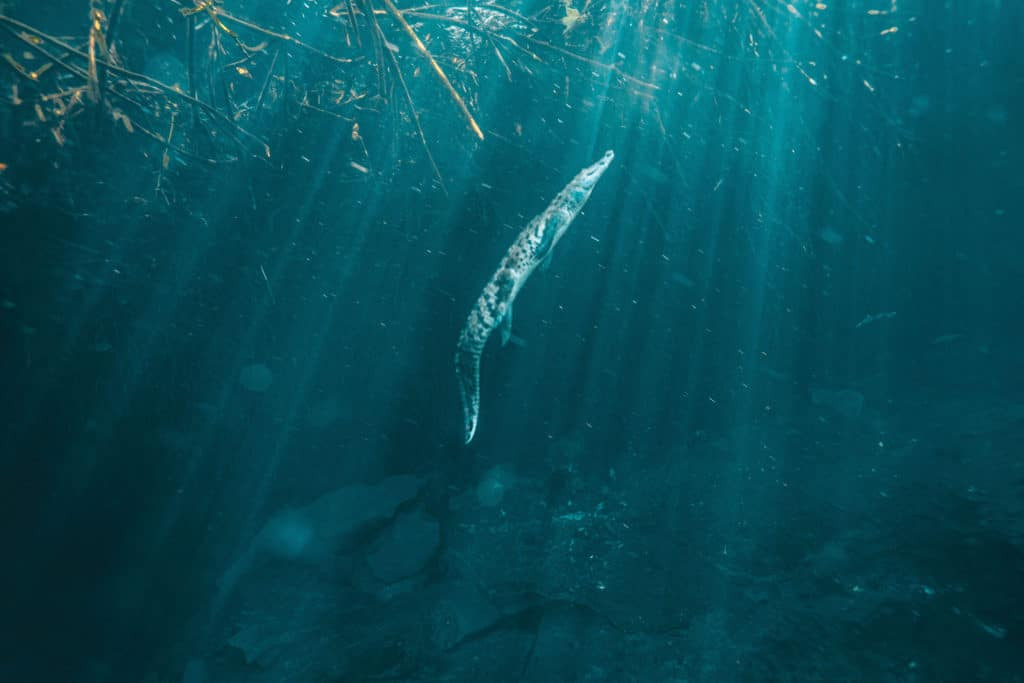 Pancho the Crocodile swimming in Casa Cenote in Tulum, Mexico
Pancho the Crocodile swimming in Casa Cenote in Tulum, Mexico
Mexico’s cenotes offer a unique and unforgettable experience, blending natural beauty, cultural significance, and thrilling wildlife encounters. While the prospect of swimming with crocodiles may seem daunting, with the right knowledge and precautions, it can be a safe and rewarding adventure. Visit gaymexico.net for more information on LGBTQ+ travel in Mexico, including tips on safe and welcoming destinations, local resources, and cultural insights. Plan your cenote adventure today and discover the magic of the Yucatan Peninsula!
Address: 3255 Wilshire Blvd, Los Angeles, CA 90010, United States
Phone: +1 (213) 380-2177
Website: gaymexico.net.
